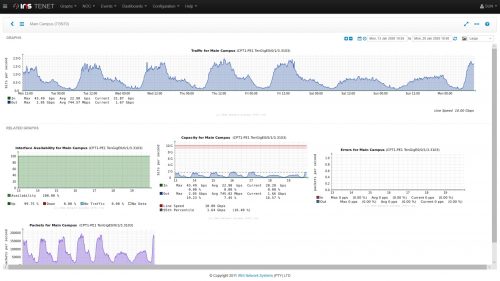[:en]
The recent internet speed problems that South Africans have been experiencing has been front page news since mid-January. How has it affected the University community?
The short answer is that in most cases, we don’t see any degradation in network performance at all. How is this possible, one may ask? The answer lies in the redundant design of our international circuits, as implemented and managed by TENET, the service provider for the tertiary education sector. When a particular network circuit is broken for some reason, like the West African cable (WACS) in the current situation, the university traffic is seamlessly re-routed via another circuit, Seacom, running along the East Africa coastline. Obviously, the risk of total network failure is enlarged by the current unavailability of WACS (and SAT3), but up to now our services remained available without a hiccup. This can be seen from the following graphs, which show constant traffic flow for the past week, 100% interface availability of the network, spare capacity available and zero network errors reported.
Other network service providers often don’t have this level of redundancy available, and may be more seriously affected. That is why ISP’s like Axxess, Afrihost and others have been struggling, and why some users might have experienced communication problems at home, or while using other networks other than the campus network.
When will this situation normalise? The WACS cable on the coast of the Congo is currently being attended to by the cable repair ship and TENET’s estimation is repairs could be completed by 11 February.
For regular updates and information on how the repair process works, follow TENET on Twitter.
[:af]
Die probleme met internetspoed wat Suid-Afrikaners tans ervaar is reeds vir weke lank in die nuus. Maar hoe het dit ons eie Universiteitsgemeenskap beïnvloed?
Die kort antwoord is dat ons, in die meeste gevalle, hoegenaamd nie ʼn degradasie in netwerkverrigting opmerk nie. Hoe is dit moontlik, wonder jy dalk? Die rede lê by TENET, die diensverskaffer vir die tersiêre opvoedingsektor, se oortolligheidsontwerp van ons internasionale stroombane. Wanneer ʼn spesifieke netwerkstroombaan, om watter rede ookal, gebreek is – soos die Wes-Afrika kabel (WACS) op die oomblik – word die universiteit se internetverkeer soomloos herlei deur ʼn ander stroombaan, Seacom, wat langs die Oos-Afrika kus loop.
Vanselfsprekend word die risiko van ʼn volslae netwerkonderbreking verhoog deur die huidige onbeskikbaarheid van die WACS (en SAT3), maar so ver het ons dienste beskikbaar gebly sonder enige glipse. Dis ook duidelik sigbaar op die grafiek onder wat deurlopende internetverkeersvloei, 100% koppelvlakbeskikbaarheid van die netwerk, ekstra beskikbare kapasiteit en geen netwerkfoute aandui.
Ander netwerkdiensverskaffers het dikwels nie hierdie vlak van oortolligheid tot hulle beskikking nie en voel meer ernstig die impak van die kabelbreuk. Dis ook hoekom IDV’s soos Axxess, Afrihost en ander by tye gesukkel het en hoekom sommige gebruikers verbindingsprobleme tuis of elders as op kampus ervaar het.
Wanneer sal die situasie weer terugkeer na normaal? Die WACS-kabel aan die kus van die Kongo word tans herstel deur die kabelherstelskip en TENET skat dat die herstelwerk teen 11 Februarie voltooi sal wees.
[:]



